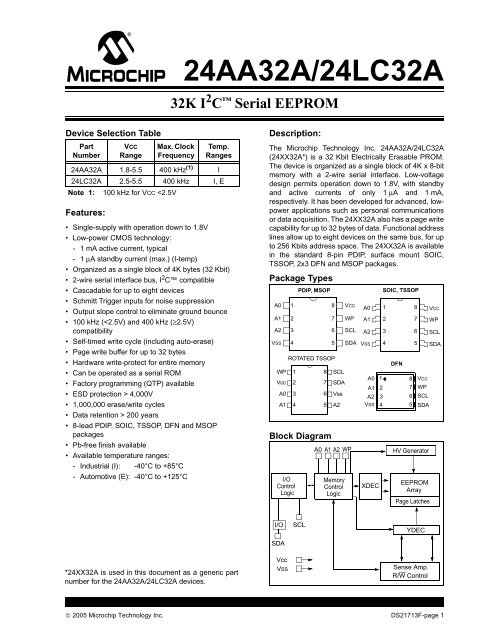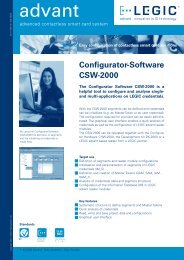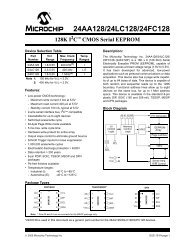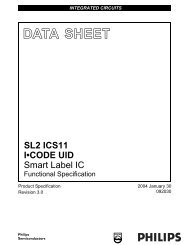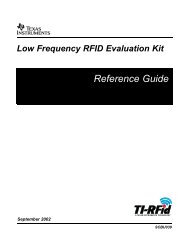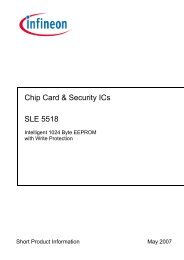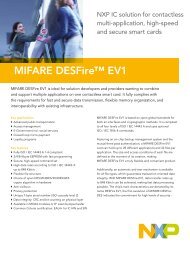Create successful ePaper yourself
Turn your PDF publications into a flip-book with our unique Google optimized e-Paper software.
<strong>24AA32A</strong>/<strong>24LC32A</strong>32K I 2 C Serial EEPROMDevice Selection TablePartNumberFeatures:VCCRangeMax. ClockFrequencyTemp.Ranges<strong>24AA32A</strong> 1.8-5.5 400 kHz (1) I<strong>24LC32A</strong> 2.5-5.5 400 kHz I, ENote 1: 100 kHz for VCC 200 years• 8-lead PDIP, SOIC, TSSOP, DFN and MSOPpackages• Pb-free finish available• Available temperature ranges:- Industrial (I): -40°C to +85°C- Automotive (E): -40°C to +125°CDescription:The Microchip Technology <strong>Inc</strong>. <strong>24AA32A</strong>/<strong>24LC32A</strong>(24XX32A*) is a 32 Kbit Electrically Erasable PROM.The device is organized as a single block of 4K x 8-bitmemory with a 2-wire serial interface. Low-voltagedesign permits operation down to 1.8V, with standbyand active currents of only 1 μA and 1 mA,respectively. It has been developed for advanced, lowpowerapplications such as personal communicationsor data acquisition. The 24XX32A also has a page writecapability for up to 32 bytes of data. Functional addresslines allow up to eight devices on the same bus, for upto 256 Kbits address space. The 24XX32A is availablein the standard 8-pin PDIP, surface mount SOIC,TSSOP, 2x3 DFN and MSOP packages.Package TypesA0A1A2VSSWPVccA0A112341234PDIP, MSOP8765Block DiagramI/OControlLogic8765ROTATED TSSOPSCLSDAVssA2VCCWPSCLSDAA0 A1 A2 WPMemoryControlLogicA0A1A2VSSSOIC, TSSOP1234A0 1A1 2A2 3VSS 4XDECDFN87658 VCC7 WP6 SCL5 SDAHV GeneratorEEPROMArrayPage LatchesVCCWPSCLSDAI/OSDASCLYDEC*24XX32A is used in this document as a generic partnumber for the <strong>24AA32A</strong>/<strong>24LC32A</strong> devices.VccVSSSense Amp.R/W Control© 2005 Microchip Technology <strong>Inc</strong>. DS21713F-page 1
<strong>24AA32A</strong>/<strong>24LC32A</strong>1.0 ELECTRICAL CHARACTERISTICSAbsolute Maximum Ratings (†)VCC.............................................................................................................................................................................6.5VAll inputs and outputs w.r.t. VSS ......................................................................................................... -0.3V to VCC +1.0VStorage temperature ...............................................................................................................................-65°C to +150°CAmbient temperature with power applied................................................................................................-40°C to +125°CESD protection on all pins ......................................................................................................................................................≥ 4kV† NOTICE: Stresses above those listed under “Absolute Maximum Ratings” may cause permanent damage tothe device. This is a stress rating only and functional operation of the device at those or any other conditionsabove those indicated in the operational listings of this specification is not implied. Exposure to maximum ratingconditions for extended periods may affect device reliability.TABLE 1-1:DC CHARACTERISTICSDC CHARACTERISTICSIndustrial (I):Automotive (E):TA = -40°C to +85°C, VCC = +1.8V to +5.5VTA = -40°C to +125°C, VCC = +2.5V to +5.5VParam.No.Symbol Characteristic Min. Typ. Max. Units ConditionsD1 — A0, A1, A2, WP, SCL — — — — —and SDA pinsD2 VIH High-level input voltage 0.7 VCC — — V —D3 VIL Low-level input voltage — — 0.3 VCC0.2 VCCD4 VHYS Hysteresis of SchmittTrigger inputs (SDA,SCL pins)VVVCC ≥ 2.5VVCC < 2.5V0.05 VCC — — V VCC ≥ 2.5V (Note 1)D5 VOL Low-level output voltage — — 0.40 V IOL = 3.0 mA, VCC = 4.5VIOL = 2.1 mA, Vcc = 2.5VD6 ILI Input leakage current — — ±1 μA VIN = VSS or VCC, WP = VSSVIN = VSS or VCC, WP = VCCD7 ILO Output leakage current — — ±1 μA VOUT = VSS or VCCD8 CIN,COUTPin capacitance(all inputs/outputs)— — 10 pF VCC = 5.0V (Note 1)TA = 25°C, FCLK = 1 MHzD9 ICC write Operating current — 0.1 3 mA VCC = 5.5V, SCL = 400 kHzD10 ICC read — 0.05 400 μAD11 ICCS Standby current ——0.01—Note 1: This parameter is periodically sampled and not 100% tested.2: Typical measurements taken at room temperature.15μAμAIndustrialAutomotiveSDA = SCL = VCC = 5.5VA0, A1, A2, WP = VSSDS21713F-page 2© 2005 Microchip Technology <strong>Inc</strong>.
<strong>24AA32A</strong>/<strong>24LC32A</strong>TABLE 1-2:AC CHARACTERISTICSAC CHARACTERISTICSIndustrial (I):Automotive (E):Param.No.1 FCLK Clock Frequency ——2 THIGH Clock High Time 60040003 TLOW Clock Low Time 13004700TA = -40°C to +85°C, VCC = +1.8V to +5.5VTA = -40°C to +125°C, VCC = +2.5V to +5.5VSymbol Characteristic Min. Max. Units Conditions4 TR SDA and SCL Rise Time(Note 1)——400100————30010005 TF SDA and SCL Fall Time — 300 ns (Note 1)6 THD:STA Start Condition Hold Time 60040007 TSU:STA Start Condition Setup Time 60047008 THD:DAT Data Input Hold Time 0 — ns (Note 2)9 TSU:DAT Data Input Setup Time 10025010 TSU:STO Stop Condition Setup Time 600400011 TSU:WP WP Setup Time 600400012 THD:WP WP Hold Time 1300470013 TAA Output Valid from Clock(Note 2)14 TBUF Bus free time: Time the busmust be free before a newtransmission can start15 TOF Output Fall Time from VIHMinimum to VIL Maximum16 TSP Input Filter Spike Suppression(SDA and SCL pins)17 TWC Write Cycle Time (byte orpage)——1300470020+0.1CB—————————————9003500——250250kHz 2.5V ≤ VCC ≤ 5.5V1.8V ≤ VCC < 2.5V (<strong>24AA32A</strong>)ns 2.5V ≤ VCC ≤ 5.5V1.8V ≤ VCC < 2.5V (<strong>24AA32A</strong>)ns 2.5V ≤ VCC ≤ 5.5V1.8V ≤ VCC < 2.5V (<strong>24AA32A</strong>)ns 2.5V ≤ VCC ≤ 5.5V1.8V ≤ VCC < 2.5V (<strong>24AA32A</strong>)ns 2.5V ≤ VCC ≤ 5.5V1.8V ≤ VCC < 2.5V (<strong>24AA32A</strong>)ns 2.5V ≤ VCC ≤ 5.5V1.8V ≤ VCC < 2.5V (<strong>24AA32A</strong>)ns 2.5V ≤ VCC ≤ 5.5V1.8V ≤ VCC < 2.5V (<strong>24AA32A</strong>)ns 2.5V ≤ VCC ≤ 5.5V1.8V ≤ VCC < 2.5V (<strong>24AA32A</strong>)ns 2.5V ≤ VCC ≤ 5.5V1.8V ≤ VCC < 2.5V (<strong>24AA32A</strong>)ns 2.5V ≤ VCC ≤ 5.5V1.8V ≤ VCC < 2.5V (<strong>24AA32A</strong>)ns 2.5V ≤ VCC ≤ 5.5V1.8V ≤ VCC < 2.5V (<strong>24AA32A</strong>)ns 2.5V ≤ VCC ≤ 5.5V1.8V ≤ VCC < 2.5V (<strong>24AA32A</strong>)ns 2.5V ≤ VCC ≤ 5.5V1.8V ≤ VCC < 2.5V (<strong>24AA32A</strong>)— 50 ns (Notes 1 and 3)— 5 ms —18 — Endurance 1M — cycles 25°C, (Note 4)Note 1: Not 100% tested. CB = total capacitance of one bus line in pF.2: As a transmitter, the device must provide an internal minimum delay time to bridge the undefined region(minimum 300 ns) of the falling edge of SCL to avoid unintended generation of Start or Stop conditions.3: The combined TSP and VHYS specifications are due to new Schmitt Trigger inputs which provide improvednoise spike suppression. This eliminates the need for a TI specification for standard operation.4: This parameter is not tested but ensured by characterization. For endurance estimates in a specificapplication, please consult the Total Endurance Model which can be obtained on Microchip’s web site atwww.microchip.com.© 2005 Microchip Technology <strong>Inc</strong>. DS21713F-page 3
<strong>24AA32A</strong>/<strong>24LC32A</strong>FIGURE 1-1:BUS TIMING DATA52D44SCLSDAIN167638 910SDAOUT1314WP(protected)(unprotected)11 12DS21713F-page 4© 2005 Microchip Technology <strong>Inc</strong>.
<strong>24AA32A</strong>/<strong>24LC32A</strong>2.0 FUNCTIONAL DESCRIPTIONThe 24XX32A supports a bidirectional, 2-wire bus anddata transmission protocol. A device that sends dataonto the bus is defined as transmitter, while a devicereceiving data is defined as a receiver. The bus has tobe controlled by a master device which generates theSerial Clock (SCL), controls the bus access and generatesthe Start and Stop conditions, while the 24XX32Aworks as slave. Both master and slave can operate astransmitter or receiver, but the master devicedetermines which mode is activated.3.0 BUS CHARACTERISTICSThe following bus protocol has been defined:• Data transfer may be initiated only when the busis not busy.• During data transfer, the data line must remainstable whenever the clock line is high. Changes inthe data line while the clock line is high will beinterpreted as a Start or Stop condition.Accordingly, the following bus conditions have beendefined (Figure 3-1).3.1 Bus Not Busy (A)Both data and clock lines remain high.3.2 Start Data Transfer (B)A high-to-low transition of the SDA line while the clock(SCL) is high determines a Start condition. Allcommands must be preceded by a Start condition.3.3 Stop Data Transfer (C)A low-to-high transition of the SDA line while the clock(SCL) is high determines a Stop condition. Alloperations must be ended with a Stop condition.3.4 Data Valid (D)The state of the data line represents valid data when,after a Start condition, the data line is stable for theduration of the high period of the clock signal.The data on the line must be changed during the lowperiod of the clock signal. There is one clock pulse perbit of data.Each data transfer is initiated with a Start condition andterminated with a Stop condition. The number of databytes transferred between Start and Stop conditions isdetermined by the master device and is, theoretically,unlimited (although only the last thirty two bytes will bestored when doing a write operation). When an overwritedoes occur, it will replace data in a first-in first-out(FIFO) fashion.3.5 AcknowledgeEach receiving device, when addressed, is obliged togenerate an acknowledge after the reception of eachbyte. The master device must generate an extra clockpulse which is associated with this Acknowledge bit.Note:The 24XX32A does not generate anyAcknowledge bits if an internalprogramming cycle is in progress.The device that acknowledges, has to pull down theSDA line during the Acknowledge clock pulse in such away that the SDA line is stable low during the highperiod of the acknowledge related clock pulse. Ofcourse, setup and hold times must be taken intoaccount. During reads, a master must signal an end ofdata to the slave by not generating an Acknowledge biton the last byte that has been clocked out of the slave.In this case, the slave (24XX32A) will leave the dataline high to enable the master to generate the Stopcondition.FIGURE 3-1:DATA TRANSFER SEQUENCE ON THE SERIAL BUSSCL(A) (B) (D) (D) (C) (A)SDAStartConditionAddress orAcknowledgeValidDataAllowedto ChangeStopCondition© 2005 Microchip Technology <strong>Inc</strong>. DS21713F-page 5
<strong>24AA32A</strong>/<strong>24LC32A</strong>3.6 Device AddressingFIGURE 3-2:CONTROL BYTE FORMATA control byte is the first byte received following theStart condition from the master device (Figure 3-2).The control byte consists of a four-bit control code. Forthe 24XX32A, this is set as ‘1010’ binary for read andwrite operations. The next three bits of the control byteare the Chip Select bits (A2, A1, A0). The Chip Selectbits allow the use of up to eight 24XX32A devices onthe same bus and are used to select which device isaccessed. The Chip Select bits in the control byte mustcorrespond to the logic levels on the corresponding A2,A1 and A0 pins for the device to respond. These bitsare in effect the three Most Significant bits of the wordaddress.The last bit of the control byte defines the operation tobe performed. When set to a ‘1’, a read operation isselected. When set to a zero, a write operation isselected. The next two bytes received define theaddress of the first data byte (Figure 3-3). Becauseonly A11 to A0 are used, the upper four address bits are“don’t care” bits. The upper address bits are transferredfirst, followed by the Less Significant bits.Following the Start condition, the 24XX32A monitorsthe SDA bus checking the device type identifier beingtransmitted and, upon receiving a ‘1010’ code andappropriate device select bits, the slave device outputsan Acknowledge signal on the SDA line. Depending onthe state of the R/W bit, the 24XX32A will select a reador write operation.SStart BitControl Code1 0 1 0 A2 A1 A0Slave AddressRead/Write BitChip SelectBitsR/WAcknowledge Bit3.7 Contiguous Addressing AcrossMultiple DevicesACKThe Chip Select bits A2, A1 and A0 can be used toexpand the contiguous address space for up to 256Kbits by adding up to eight 24XX32A devices on thesame bus. In this case, software can use A0 of the controlbyte as address bit A12; A1 as address bit A13; andA2 as address bit A14. It is not possible to sequentiallyread across device boundaries.FIGURE 3-3:ADDRESS SEQUENCE BIT ASSIGNMENTSControl Byte Address High Byte Address Low Byte1 0 1 0A2A1A0 R/W x x x xA11A10 A 9A A A8 7• • • • • • 0ControlCodeChipSelectBitsx = “don’t care” bitDS21713F-page 6© 2005 Microchip Technology <strong>Inc</strong>.
<strong>24AA32A</strong>/<strong>24LC32A</strong>4.0 WRITE OPERATIONS4.1 Byte WriteFollowing the Start condition from the master, thecontrol code (4 bits), the Chip Select (3 bits), and theR/W bit (which is a logic low) are clocked onto the busby the master transmitter. This indicates to theaddressed slave receiver that the address high bytewill follow once it has generated an Acknowledge bitduring the ninth clock cycle. Therefore, the next bytetransmitted by the master is the high-order byte of theword address and will be written into the AddressPointer of the 24XX32A. The next byte is the LeastSignificant Address Byte. After receiving anotherAcknowledge signal from the 24XX32A, the masterdevice will transmit the data word to be written into theaddressed memory location. The 24XX32A acknowledgesagain and the master generates a Stopcondition. This initiates the internal write cycle and,during this time, the 24XX32A will not generateAcknowledge signals (Figure 4-1). If an attempt ismade to write to the array with the WP pin held high,the device will acknowledge the command, but nowrite cycle will occur. No data will be written and thedevice will immediately accept a new command. Aftera byte Write command, the internal address counterwill point to the address location following the one thatwas just written.4.2 Page WriteThe write control byte, word address and the first databyte are transmitted to the 24XX32A in the same wayas in a byte write. However, instead of generating aStop condition, the master transmits up to 31 additionalbytes which are temporarily stored in the on-chip pagebuffer and will be written into memory once the masterhas transmitted a Stop condition. Upon receipt of eachword, the five lower Address Pointer bits are internallyincremented by ‘1’. If the master should transmit morethan 32 bytes prior to generating the Stop condition, theaddress counter will roll over and the previouslyreceived data will be overwritten. As with the byte writeoperation, once the Stop condition is received, aninternal write cycle will begin (Figure 4-2). If an attemptis made to write to the array with the WP pin held high,the device will acknowledge the command, but no writecycle will occur, no data will be written, and the devicewill immediately accept a new command.Note:Page write operations are limited to writingbytes within a single physical page,regardless of the number of bytesactually being written. Physical pageboundaries start at addresses that areinteger multiples of the page buffer size (or‘page size’) and, end at addresses that areinteger multiples of [page size – 1]. If aPage Write command attempts to writeacross a physical page boundary, theresult is that the data wraps around to thebeginning of the current page (overwritingdata previously stored there), instead ofbeing written to the next page as might beexpected. It is therefore necessary for theapplication software to prevent page writeoperations that would attempt to cross apage boundary.4.3 Write ProtectionThe WP pin allows the user to write-protect the entirearray (000-FFF) when the pin is tied to VCC. If tied toVSS the write protection is disabled. The WP pin issampled at the Stop bit for every Write command(Figure 3-1). Toggling the WP pin after the Stop bit willhave no effect on the execution of the write cycle.© 2005 Microchip Technology <strong>Inc</strong>. DS21713F-page 7
<strong>24AA32A</strong>/<strong>24LC32A</strong>FIGURE 4-1:BYTE WRITEBus ActivityMasterSDA LineSTARTControlByteS 1010A A A 2 1 0 0AddressHigh BytexxxxAddressLow ByteDataSTOPPBus ActivityACKACKACKACKx = “don’t care” bitFIGURE 4-2:PAGE WRITEBus ActivityMasterSDA LineSTARTControlByteS 1010A A A 2 1 0 0AddressHigh BytexxxxAddressLow Byte Data Byte 0Data Byte 31STOPPBus Activityx = “don’t care” bitACKACKACKACKACKDS21713F-page 8© 2005 Microchip Technology <strong>Inc</strong>.
<strong>24AA32A</strong>/<strong>24LC32A</strong>5.0 ACKNOWLEDGE POLLINGSince the device will not acknowledge during a writecycle, this can be used to determine when the cycle iscomplete (this feature can be used to maximize busthroughput). Once the Stop condition for a Writecommand has been issued from the master, the deviceinitiates the internally-timed write cycle. ACK pollingcan then be initiated immediately. This involves themaster sending a Start condition followed by the controlbyte for a Write command (R/W = 0). If the device is stillbusy with the write cycle, then no ACK will be returned.If no ACK is returned, the Start bit and control byte mustbe re-sent. If the cycle is complete, the device willreturn the ACK and the master can then proceed withthe next Read or Write command. See Figure 5-1 forflow diagram of this operation.FIGURE 5-1:ACKNOWLEDGE POLLINGFLOWSendWrite CommandSend StopCondition toInitiate Write CycleSend StartSend Control Bytewith R/W = 0Did DeviceAcknowledge(ACK = 0)?NoYesNextOperation© 2005 Microchip Technology <strong>Inc</strong>. DS21713F-page 9
<strong>24AA32A</strong>/<strong>24LC32A</strong>6.0 READ OPERATIONRead operations are initiated in the same way as writeoperations, with the exception that the R/W bit of thecontrol byte is set to ‘1’. There are three basic types ofread operations: current address read, random readand sequential read.6.1 Current Address ReadThe 24XX32A contains an address counter that maintainsthe address of the last word accessed, internallyincremented by ‘1’. Therefore, if the previous readaccess was to address ‘n’ (n is any legal address), thenext current address read operation would access datafrom address n + 1.Upon receipt of the control byte with R/W bit set to ‘1’,the 24XX32A issues an acknowledge and transmits the8-bit data word. The master will not acknowledge thetransfer, but does generate a Stop condition and the24XX32A discontinues transmission (Figure 6-1).6.3 Sequential ReadSequential reads are initiated in the same way as arandom read, except that once the 24XX32A transmitsthe first data byte, the master issues an acknowledgeas opposed to the Stop condition used in a randomread. This acknowledge directs the 24XX32A totransmit the next sequentially addressed 8-bit word(Figure 6-3). Following the final byte transmitted to themaster, the master will NOT generate an acknowledge,but will generate a Stop condition. To provide sequentialreads, the 24XX32A contains an internal AddressPointer which is incremented by ‘1’ upon completion ofeach operation. This Address Pointer allows the entirememory contents to be serially read during oneoperation. The internal Address Pointer will automaticallyroll over from address FFF to address 000 if themaster acknowledges the byte received from the arrayaddress FFF.6.2 Random ReadRandom read operations allow the master to accessany memory location in a random manner. To performthis type of read operation, the word address mustfirst be set. This is accomplished by sending the wordaddress to the 24XX32A as part of a write operation(R/W bit set to ‘0’). Once the word address is sent, themaster generates a Start condition following theacknowledge. This terminates the write operation, butnot before the internal Address Pointer is set. Themaster issues the control byte again, but with the R/Wbit set to a ‘1’. The 24XX32A will then issue anacknowledge and transmit the 8-bit data word. Themaster will not acknowledge the transfer, but doesgenerate a Stop condition which causes the 24XX32Ato discontinue transmission (Figure 6-2). After arandom Read command, the internal address counterwill point to the address location following the one thatwas just read.FIGURE 6-1:CURRENT ADDRESS READBus ActivityMasterSTARTControlByteData (n)STOPSDA LineSPBus ActivityACKNOACKDS21713F-page 10© 2005 Microchip Technology <strong>Inc</strong>.
<strong>24AA32A</strong>/<strong>24LC32A</strong>FIGURE 6-2:Bus ActivityMasterSDA LineBus ActivitySTARTx = “don’t care” bitRANDOM READControlByteS 1010 AAA 0210ACKAddressHigh BytexxxxACKAddressLow ByteACKSTARTControlByteS 1010 AAA 1210ACKDataByteSTOPPNOACKFIGURE 6-3:Bus ActivityMasterSDA LineBus ActivitySEQUENTIAL READControlByte Data n Data n + 1 Data n + 2 Data n + xACKACKACKACKNOACKSTOPP© 2005 Microchip Technology <strong>Inc</strong>. DS21713F-page 11
<strong>24AA32A</strong>/<strong>24LC32A</strong>7.0 PIN DESCRIPTIONSThe descriptions of the pins are listed in Table 7-1.TABLE 7-1:PIN FUNCTION TABLEName PDIP SOIC TSSOP DFN MSOPROTATEDTSSOPDescriptionA0 1 1 1 1 1 3 Chip Address InputA1 2 2 2 2 2 4 Chip Address InputA2 3 3 3 3 3 5 Chip Address InputVSS 4 4 4 4 4 6 GroundSDA 5 5 5 5 5 7 Serial Address/Data I/OSCL 6 6 6 6 6 8 Serial ClockWP 7 7 7 7 7 1 Write-Protect InputVCC 8 8 8 8 8 2 +1.8V to 5.5V Power Supply7.1 A0, A1, A2 Chip Address InputsThe A0, A1 and A2 inputs are used by the 24XX32A formultiple device operation. The levels on these inputsare compared with the corresponding bits in the slaveaddress. The chip is selected if the comparison is true.Up to eight devices may be connected to the same busby using different Chip Select bit combinations. Theseinputs must be connected to either VCC or VSS.In most applications, the chip address inputs A0, A1and A2 are hard-wired to logic ‘0’ or logic ‘1’. Forapplications in which these pins are controlled by amicrocontroller or other programmable device, the chipaddress pins must be driven to logic ‘0’ or logic ‘1’before normal device operation can proceed.7.3 Serial Clock (SCL)The SCL input is used to synchronize the data transferto and from the device.7.4 Write-Protect (WP)This pin must be connected to either VSS or VCC. If tiedto VSS, write operations are enabled. If tied to VCC,write operations are inhibited but read operations arenot affected.7.2 Serial Data (SDA)SDA is a bidirectional pin used to transfer addressesand data into and out of the device. It is an open-drainterminal, therefore, the SDA bus requires a pull-upresistor to VCC (typical 10 kΩ for 100 kHz, 2 kΩ for400 kHz)For normal data transfer, SDA is allowed to changeonly during SCL low. Changes during SCL high arereserved for indicating Start and Stop conditions.DS21713F-page 12© 2005 Microchip Technology <strong>Inc</strong>.
<strong>24AA32A</strong>/<strong>24LC32A</strong>8.0 PACKAGING INFORMATION8.1 Package Marking Information8-Lead PDIP (300 mil)Example:XXXXXXXXT/XXXNNNYYWW<strong>24LC32A</strong>I/P e313F05278-Lead SOIC (150 mil)Example:XXXXXXXTXXXXYYWWNNN<strong>24LC32A</strong>ISN e3 052713F8-Lead SOIC (208 mil)Example:XXXXXXXXT/XXXXXXYYWWNNN<strong>24LC32A</strong>I/SM e3052713F8-Lead TSSOPXXXXTYWWNNNExample:4LAI52713F8-Lead 2x3 DFNExample:XXXYWWNN264527138-Lead MSOPExample:XXXXXTYWWNNN4L32AI52713F© 2005 Microchip Technology <strong>Inc</strong>. DS21713F-page 13
<strong>24AA32A</strong>/<strong>24LC32A</strong>1st Line Marking CodesPart NumberTSSOPDFNMSOPStandard Rotated I Temp. E Temp.<strong>24AA32A</strong> 4AA 4AAX 4A32AT 261 262<strong>24LC32A</strong> 4LA 4LAX 4L32AT 264 265Note: T = Temperature grade (I, E)Legend: XX...X Part number or part number codeT Temperature (I, E)Y Year code (last digit of calendar year)YY Year code (last 2 digits of calendar year)WW Week code (week of January 1 is week ‘01’)NNNe3Alphanumeric traceability code (2 characters for small packages)Pb-free JEDEC designator for Matte Tin (Sn)Note:Note:For very small packages with no room for the Pb-free JEDEC designatore3 , the marking will only appear on the outer carton or reel label.In the event the full Microchip part number cannot be marked on one line, it willbe carried over to the next line, thus limiting the number of availablecharacters for customer-specific information.Note:Please visit www.microchip.com/Pbfree for the latest information on Pb-free conversion.*Standard OTP marking consists of Microchip part number, year code, week code, and traceability code.DS21713F-page 14© 2005 Microchip Technology <strong>Inc</strong>.
<strong>24AA32A</strong>/<strong>24LC32A</strong>8-Lead Plastic Dual In-line (P) – 300 mil (PDIP)E12Dn1αEAA2cA1LβeBB1BpUnits INCHES* MILLIMETERSDimension Limits MIN NOM MAX MIN NOM MAXNumber of Pins n 8 8Pitch p .100 2.54Top to Seating Plane A .140 .155 .170 3.56 3.94 4.32Molded Package Thickness A2 .115 .130 .145 2.92 3.30 3.68Base to Seating Plane A1 .015 0.38Shoulder to Shoulder Width E .300 .313 .325 7.62 7.94 8.26Molded Package Width E1 .240 .250 .260 6.10 6.35 6.60Overall Length D .360 .373 .385 9.14 9.46 9.78Tip to Seating Plane L .125 .130 .135 3.18 3.30 3.43Lead Thickness c .008 .012 .015 0.20 0.29 0.38Upper Lead Width B1 .045 .058 .070 1.14 1.46 1.78Lower Lead Width B .014 .018 .022 0.36 0.46 0.56Overall Row Spacing § eB .310 .370 .430 7.87 9.40 10.92Mold Draft Angle Top α 5 10 15 5 10 15Mold Draft Angle Bottom β 5 10 15 5 10 15* Controlling Parameter§ Significant CharacteristicNotes:Dimensions D and E1 do not include mold flash or protrusions. Mold flash or protrusions shall not exceed.010” (0.254mm) per side.JEDEC Equivalent: MS-001Drawing No. C04-018© 2005 Microchip Technology <strong>Inc</strong>. DS21713F-page 15
<strong>24AA32A</strong>/<strong>24LC32A</strong>8-Lead Plastic Small Outline (SN) – Narrow, 150 mil (SOIC)EE1p2DBn145°hαcAA2φβLA1UnitsINCHES*MILLIMETERSDimension Limits MIN NOM MAX MIN NOM MAXNumber of Pinsn88Pitchp.0501.27Overall HeightA .053 .061 .069 1.35 1.55 1.75Molded Package Thickness A2 .052 .056 .061 1.32 1.42 1.55Standoff §A1 .004 .007 .010 0.10 0.18 0.25Overall WidthE .228 .237 .244 5.79 6.02 6.20Molded Package WidthE1 .146 .154 .157 3.71 3.91 3.99Overall LengthD .189 .193 .197 4.80 4.90 5.00Chamfer Distanceh .010 .015 .020 0.25 0.38 0.51Foot LengthL .019 .025 .030 0.48 0.62 0.76Foot Angle φ 0 4 8 0 4 8Lead Thicknessc .008 .009 .010 0.20 0.23 0.25Lead WidthB .013 .017 .020 0.33 0.42 0.51Mold Draft Angle Topα0 12 150 12 15Mold Draft Angle Bottomβ0 12 150 12 15* Controlling Parameter§ Significant CharacteristicNotes:Dimensions D and E1 do not include mold flash or protrusions. Mold flash or protrusions shall not exceed.010” (0.254mm) per side.JEDEC Equivalent: MS-012Drawing No. C04-057DS21713F-page 16© 2005 Microchip Technology <strong>Inc</strong>.
<strong>24AA32A</strong>/<strong>24LC32A</strong>8-Lead Plastic Small Outline (SM) – Medium, 208 mil (SOIC)EE1p2DBn1αcAA2φβLA1UnitsINCHES*MILLIMETERSDimension Limits MIN NOM MAX MIN NOM MAXNumber of Pinsn88Pitchp.0501.27Overall HeightA .070 .075 .080 1.78 1.97 2.03Molded Package Thickness A2 .069 .074 .078 1.75 1.88 1.98Standoff §A1 .002 .005 .010 0.05 0.13 0.25Overall WidthE .300 .313 .325 7.62 7.95 8.26Molded Package WidthE1 .201 .208 .212 5.11 5.28 5.38Overall LengthD .202 .205 .210 5.13 5.21 5.33Foot LengthL .020 .025 .030 0.51 0.64 0.76Foot Angle φ 0 4 8 0 4 8Lead Thicknessc .008 .009 .010 0.20 0.23 0.25Lead WidthB .014 .017 .020 0.36 0.43 0.51Mold Draft Angle Topα0 12 150 12 15Mold Draft Angle Bottomβ0 12 150 12 15* Controlling Parameter§ Significant CharacteristicNotes:Dimensions D and E1 do not include mold flash or protrusions. Mold flash or protrusions shall not exceed.010” (0.254mm) per side.Drawing No. C04-056© 2005 Microchip Technology <strong>Inc</strong>. DS21713F-page 17
<strong>24AA32A</strong>/<strong>24LC32A</strong>8-Lead Plastic Thin Shrink Small Outline (ST) – 4.4 mm (TSSOP)EE1p2DBn1AαcφA1A2βLUnitsINCHESMILLIMETERS*Dimension Limits MIN NOM MAX MIN NOM MAXNumber of Pinsn88Pitchp.0260.65Overall HeightA.0431.10Molded Package Thickness A2 .033 .035 .037 0.85 0.90 0.95Standoff §A1 .002 .004 .006 0.05 0.10 0.15Overall WidthE .246 .251 .256 6.25 6.38 6.50Molded Package WidthE1 .169 .173 .177 4.30 4.40 4.50Molded Package LengthD .114 .118 .122 2.90 3.00 3.10Foot LengthL .020 .024 .028 0.50 0.60 0.70Foot Angle φ 0 4 8 0 4 8Lead Thicknessc .004 .006 .008 0.09 0.15 0.20Lead WidthB .007 .010 .012 0.19 0.25 0.30Mold Draft Angle Topα05 1005 10Mold Draft Angle Bottomβ05 1005 10* Controlling Parameter§ Significant CharacteristicNotes:Dimensions D and E1 do not include mold flash or protrusions. Mold flash or protrusions shall not exceed.005” (0.127mm) per side.JEDEC Equivalent: MO-153Drawing No. C04-086DS21713F-page 18© 2005 Microchip Technology <strong>Inc</strong>.
<strong>24AA32A</strong>/<strong>24LC32A</strong>8-Lead Plastic Dual Flat No Lead Package (MC) 2x3x0.9 mm Body (DFN) – Saw SingulatedpDbnLEE2PIN 1ID INDEXAREA(NOTE 2)TOP VIEWEXPOSEDMETALPADD22 1BOTTOM VIEWA3A1AEXPOSEDTIE BAR(NOTE 1)UnitsINCHESMILLIMETERS*Dimension LimitsMIN NOM MAX MIN NOMNumber of Pinsn88Pitchp.020 BSC0.50 BSCOverall HeightA.031 .035 .039 0.80 0.90StandoffA1.000 .001 .002 0.00 0.02Contact ThicknessA3.008 REF.0.20 REF.Overall LengthD.079 BSC2.00 BSCExposed Pad LengthOverall WidthD2E.055--.118 BSC.064 1.39--3.00 BSCExposed Pad WidthE2.047-- .071 1.20--Contact Widthb.008 .010 .012 0.20 0.25Contact Length*Controlling ParameterL.012 .016 .020 0.30 0.40Notes:1. Package may have one or more exposed tie bars at ends.2. Pin 1 visual index feature may vary, but must be located within the hatched area.3. Exposed pad dimensions vary with paddle size.4. JEDEC equivalent: MO-229Drawing No. C04-123(Note 3)(Note 3)Revised 05/24/04MAX1.000.051.621.800.300.50© 2005 Microchip Technology <strong>Inc</strong>. DS21713F-page 19
<strong>24AA32A</strong>/<strong>24LC32A</strong>8-Lead Plastic Micro Small Outline Package (MS) (MSOP)EE1pBn 12DαcφAA1A2β(F)LUnitsINCHESMILLIMETERS*Dimension Limits MIN NOM MAX MIN NOMNumber of Pinsn88Pitchp.026 BSC0.65 BSCOverall HeightA-- .043- -Molded Package Thickness A2 .030 .033 .037 0.75 0.85StandoffA1 .000- .006 0.00-Overall WidthE.193 TYP.4.90 BSCMolded Package WidthE1.118 BSC3.00 BSCOverall LengthD.118 BSC3.00 BSCFoot LengthL .016 .024 .031 0.40 0.60Footprint (Reference)Foot AngleFφ0°.037 REF- 8° 0°0.95 REF-Lead Thicknessc .003 .006 .009 0.08-Lead WidthB .009 .012 .016 0.22-Mold Draft Angle Topα5°- 15° 5° -Mold Draft Angle Bottomβ5° - 15° 5° -*Controlling ParameterNotes:Dimensions D and E1 do not include mold flash or protrusions. Mold flash or protrusions shall notexceed .010" (0.254mm) per side.JEDEC Equivalent: MO-187Drawing No. C04-111MAX1.100.950.150.808°0.230.4015°15°DS21713F-page 20© 2005 Microchip Technology <strong>Inc</strong>.
<strong>24AA32A</strong>/<strong>24LC32A</strong>APPENDIX A: REVISION HISTORYRevision DCorrections to Section 1.0, Electrical Characteristics.Revision EAdded DFN package.Revision FRevised Sections 4.3, 7.2 and 7.4.© 2005 Microchip Technology <strong>Inc</strong>. DS21713F-page 21
<strong>24AA32A</strong>/<strong>24LC32A</strong>NOTES:DS21713F-page 22© 2005 Microchip Technology <strong>Inc</strong>.
<strong>24AA32A</strong>/<strong>24LC32A</strong>THE MICROCHIP WEB SITEMicrochip provides online support via our WWW site atwww.microchip.com. This web site is used as a meansto make files and information easily available tocustomers. Accessible by using your favorite Internetbrowser, the web site contains the followinginformation:• Product Support – Data sheets and errata,application notes and sample programs, designresources, user’s guides and hardware supportdocuments, latest software releases and archivedsoftware• General Technical Support – Frequently AskedQuestions (FAQ), technical support requests,online discussion groups, Microchip consultantprogram member listing• Business of Microchip – Product selector andordering guides, latest Microchip press releases,listing of seminars and events, listings ofMicrochip sales offices, distributors and factoryrepresentativesCUSTOMER SUPPORTUsers of Microchip products can receive assistancethrough several channels:• Distributor or Representative• Local Sales Office• Field Application Engineer (FAE)• Technical Support• Development Systems Information LineCustomers should contact their distributor,representative or field application engineer (FAE) forsupport. Local sales offices are also available to helpcustomers. A listing of sales offices and locations isincluded in the back of this document.Technical support is available through the web siteat: http://support.microchip.comCUSTOMER CHANGE NOTIFICATIONSERVICEMicrochip’s customer notification service helps keepcustomers current on Microchip products. Subscriberswill receive e-mail notification whenever there arechanges, updates, revisions or errata related to aspecified product family or development tool of interest.To register, access the Microchip web site atwww.microchip.com, click on Customer ChangeNotification and follow the registration instructions.© 2005 Microchip Technology <strong>Inc</strong>. DS21713F-page 23
<strong>24AA32A</strong>/<strong>24LC32A</strong>READER RESPONSEIt is our intention to provide you with the best documentation possible to ensure successful use of your Microchip product.If you wish to provide your comments on organization, clarity, subject matter, and ways in which our documentationcan better serve you, please FAX your comments to the Technical Publications Manager at (480) 792-4150.Please list the following information, and use this outline to provide us with your comments about this document.To:RE:Technical Publications ManagerReader ResponseTotal Pages Sent ________From: NameCompanyAddressCity / State / ZIP / CountryTelephone: (_______) _________ - _________Application (optional):Would you like a reply? Y NFAX: (______) _________ - _________Device:<strong>24AA32A</strong>/<strong>24LC32A</strong>Literature Number:DS21713FQuestions:1. What are the best features of this document?2. How does this document meet your hardware and software development needs?3. Do you find the organization of this document easy to follow? If not, why?4. What additions to the document do you think would enhance the structure and subject?5. What deletions from the document could be made without affecting the overall usefulness?6. Is there any incorrect or misleading information (what and where)?7. How would you improve this document?DS21713F-page 24© 2005 Microchip Technology <strong>Inc</strong>.
<strong>24AA32A</strong>/<strong>24LC32A</strong>PRODUCT IDENTIFICATION SYSTEMTo order or obtain information, e.g., on pricing or delivery, refer to the factory or the listed sales office.PART NO. X /XXDeviceTemperatureRangePackageDevice: <strong>24AA32A</strong>: 1.8V, 32 Kbit I 2 C Serial EEPROM<strong>24AA32A</strong>T: 1.8V, 32 Kbit I 2 C Serial EEPROM(Tape and Reel)<strong>24AA32A</strong>X 1.8V, 32 Kbit I 2 C Serial EEPROM inalternate pinout (ST only)<strong>24AA32A</strong>XT 1.8V, 32 Kbit I 2 C Serial EEPROM inalternate pinout (ST only)<strong>24LC32A</strong>: 2.5V, 32 Kbit I 2 C Serial EEPROM<strong>24LC32A</strong>T: 2.5V, 32 Kbit I 2 C Serial EEPROM(Tape and Reel)<strong>24LC32A</strong>X 2.5V, 32 Kbit I 2 C Serial EEPROM inalternate pinout (ST only)<strong>24LC32A</strong>XT 2.5V, 32 Kbit I 2 C Serial EEPROM inalternate pinout (ST only)TemperatureRange:I = -40°C to +85°CE = -40°C to +125°CPackage: P = Plastic DIP (300 mil body), 8-leadSN = Plastic SOIC (150 mil body), 8-leadSM = Plastic SOIC (208 mil body), 8-leadST = Plastic TSSOP (4.4 mm), 8-leadMS = Plastic Micro Small Outline (MSOP), 8-leadMC = 2x3 DFN, 8-leadXLead FinishExamples:a) <strong>24AA32A</strong>-I/P: Industrial Temperature,1.8V,PDIP packageb) <strong>24AA32A</strong>-I/SN: Industrial Temperature,1.8V,SOIC packagec) <strong>24AA32A</strong>-I/SM: Industrial Temperature.,1.8V,SOIC (208 mil) packaged) <strong>24AA32A</strong>X-I/ST: Industrial Temp.,1.8V,Rotated TSSOP packagee) <strong>24AA32A</strong>-I/ST: Industrial Temperature.,1.8V,TSSOP packagef) <strong>24LC32A</strong>-I/P: Industrial Temperature, 2.5V,PDIP packageg) <strong>24LC32A</strong>-E/SN: Automotive Temperature,2.5V SOIC packageh) <strong>24LC32A</strong>-E/SM: Automotive Temperature,2.5V SOIC (208 mil) packagei) <strong>24LC32A</strong>X-E/ST: Automotive Temperature,2.5V, Rotated TSSOP packagej) <strong>24LC32A</strong>T-I/ST: Industrial Temperature, 2.5V,TSSOP package, Tape and ReelLead Finish: Blank = Pb-free – Matte Tin (see Note 1)G = Pb-free – Matte Tin onlyNote 1:Most products manufactured after January 2005 will have a Matte Tin (Pb-free) finish. Most products manufacturedbefore January 2005 will have a finish of approximately 63% Sn and 37% Pb (Sn/Pb).Please visit www.microchip.com for the latest information on Pb-free conversion, including conversion date codes.Sales and SupportData SheetsProducts supported by a preliminary Data Sheet may have an errata sheet describing minor operational differences andrecommended workarounds. To determine if an errata sheet exists for a particular device, please contact one of the following:1. Your local Microchip sales office2. The Microchip Corporate Literature Center U.S. FAX: (480) 792-72773. The Microchip Worldwide Site (www.microchip.com)Please specify which device, revision of silicon and Data Sheet (include Literature #) you are using.New Customer Notification SystemRegister on our web site (www.microchip.com/cn) to receive the most current information on our products.© 2005 Microchip Technology <strong>Inc</strong>. DS21713F-page 25
<strong>24AA32A</strong>/<strong>24LC32A</strong>NOTES:DS21713F-page 26© 2005 Microchip Technology <strong>Inc</strong>.
Note the following details of the code protection feature on Microchip devices:• Microchip products meet the specification contained in their particular Microchip Data Sheet.• Microchip believes that its family of products is one of the most secure families of its kind on the market today, when used in theintended manner and under normal conditions.• There are dishonest and possibly illegal methods used to breach the code protection feature. All of these methods, to ourknowledge, require using the Microchip products in a manner outside the operating specifications contained in Microchip’s DataSheets. Most likely, the person doing so is engaged in theft of intellectual property.• Microchip is willing to work with the customer who is concerned about the integrity of their code.• Neither Microchip nor any other semiconductor manufacturer can guarantee the security of their code. Code protection does notmean that we are guaranteeing the product as “unbreakable.”Code protection is constantly evolving. We at Microchip are committed to continuously improving the code protection features of ourproducts. Attempts to break Microchip’s code protection feature may be a violation of the Digital Millennium Copyright Act. If such actsallow unauthorized access to your software or other copyrighted work, you may have a right to sue for relief under that Act.Information contained in this publication regarding deviceapplications and the like is provided only for your convenienceand may be superseded by updates. It is your responsibility toensure that your application meets with your specifications.MICROCHIP MAKES NO REPRESENTATIONS OR WAR-RANTIES OF ANY KIND WHETHER EXPRESS OR IMPLIED,WRITTEN OR ORAL, STATUTORY OR OTHERWISE,RELATED TO THE INFORMATION, INCLUDING BUT NOTLIMITED TO ITS CONDITION, QUALITY, PERFORMANCE,MERCHANTABILITY OR FITNESS FOR PURPOSE.Microchip disclaims all liability arising from this information andits use. Use of Microchip’s products as critical components inlife support systems is not authorized except with expresswritten approval by Microchip. No licenses are conveyed,implicitly or otherwise, under any Microchip intellectual propertyrights.TrademarksThe Microchip name and logo, the Microchip logo, Accuron,dsPIC, KEELOQ, microID, MPLAB, PIC, PICmicro, PICSTART,PRO MATE, PowerSmart, rfPIC, and SmartShunt areregistered trademarks of Microchip Technology <strong>Inc</strong>orporatedin the U.S.A. and other countries.AmpLab, FilterLab, Migratable Memory, MXDEV, MXLAB,PICMASTER, SEEVAL, SmartSensor and The EmbeddedControl Solutions Company are registered trademarks ofMicrochip Technology <strong>Inc</strong>orporated in the U.S.A.Analog-for-the-Digital Age, Application Maestro, dsPICDEM,dsPICDEM.net, dsPICworks, ECAN, ECONOMONITOR,FanSense, FlexROM, fuzzyLAB, In-Circuit SerialProgramming, ICSP, ICEPIC, Linear Active Thermistor,MPASM, MPLIB, MPLINK, MPSIM, PICkit, PICDEM,PICDEM.net, PICLAB, PICtail, PowerCal, PowerInfo,PowerMate, PowerTool, rfLAB, rfPICDEM, Select Mode,Smart Serial, SmartTel, Total Endurance and WiperLock aretrademarks of Microchip Technology <strong>Inc</strong>orporated in theU.S.A. and other countries.SQTP is a service mark of Microchip Technology <strong>Inc</strong>orporatedin the U.S.A.All other trademarks mentioned herein are property of theirrespective companies.© 2005, Microchip Technology <strong>Inc</strong>orporated, Printed in theU.S.A., All Rights Reserved.Printed on recycled paper.Microchip received ISO/TS-16949:2002 quality system certification forits worldwide headquarters, design and wafer fabrication facilities inChandler and Tempe, Arizona and Mountain View, California inOctober 2003. The Company’s quality system processes andprocedures are for its PICmicro ® 8-bit MCUs, KEELOQ ® code hoppingdevices, Serial EEPROMs, microperipherals, nonvolatile memory andanalog products. In addition, Microchip’s quality system for the designand manufacture of development systems is ISO 9001:2000 certified.© 2005 Microchip Technology <strong>Inc</strong>. DS21713F-page 27
WORLDWIDE SALES AND SERVICEAMERICASCorporate Office2355 West Chandler Blvd.Chandler, AZ 85224-6199Tel: 480-792-7200Fax: 480-792-7277Technical Support:http://support.microchip.comWeb Address:www.microchip.comAtlantaAlpharetta, GATel: 770-640-0034Fax: 770-640-0307BostonWestborough, MATel: 774-760-0087Fax: 774-760-0088ChicagoItasca, ILTel: 630-285-0071Fax: 630-285-0075DallasAddison, TXTel: 972-818-7423Fax: 972-818-2924DetroitFarmington Hills, MITel: 248-538-2250Fax: 248-538-2260KokomoKokomo, INTel: 765-864-8360Fax: 765-864-8387Los AngelesMission Viejo, CATel: 949-462-9523Fax: 949-462-9608San JoseMountain View, CATel: 650-215-1444Fax: 650-961-0286TorontoMississauga, Ontario,CanadaTel: 905-673-0699Fax: 905-673-6509ASIA/PACIFICAustralia - SydneyTel: 61-2-9868-6733Fax: 61-2-9868-6755China - BeijingTel: 86-10-8528-2100Fax: 86-10-8528-2104China - ChengduTel: 86-28-8676-6200Fax: 86-28-8676-6599China - FuzhouTel: 86-591-8750-3506Fax: 86-591-8750-3521China - Hong Kong SARTel: 852-2401-1200Fax: 852-2401-3431China - QingdaoTel: 86-532-8502-7355Fax: 86-532-8502-7205China - ShanghaiTel: 86-21-5407-5533Fax: 86-21-5407-5066China - ShenyangTel: 86-24-2334-2829Fax: 86-24-2334-2393China - ShenzhenTel: 86-755-8203-2660Fax: 86-755-8203-1760China - ShundeTel: 86-757-2839-5507Fax: 86-757-2839-5571China - WuhanTel: 86-27-5980-5300Fax: 86-27-5980-5118China - XianTel: 86-29-8833-7250Fax: 86-29-8833-7256ASIA/PACIFICIndia - BangaloreTel: 91-80-2229-0061Fax: 91-80-2229-0062India - New DelhiTel: 91-11-5160-8631Fax: 91-11-5160-8632India - PuneTel: 91-20-2566-1512Fax: 91-20-2566-1513Japan - YokohamaTel: 81-45-471- 6166Fax: 81-45-471-6122Korea - GumiTel: 82-54-473-4301Fax: 82-54-473-4302Korea - SeoulTel: 82-2-554-7200Fax: 82-2-558-5932 or82-2-558-5934Malaysia - PenangTel: 604-646-8870Fax: 604-646-5086Philippines - ManilaTel: 632-634-9065Fax: 632-634-9069SingaporeTel: 65-6334-8870Fax: 65-6334-8850Taiwan - Hsin ChuTel: 886-3-572-9526Fax: 886-3-572-6459Taiwan - KaohsiungTel: 886-7-536-4818Fax: 886-7-536-4803Taiwan - TaipeiTel: 886-2-2500-6610Fax: 886-2-2508-0102Thailand - BangkokTel: 66-2-694-1351Fax: 66-2-694-1350EUROPEAustria - WeisTel: 43-7242-2244-399Fax: 43-7242-2244-393Denmark - CopenhagenTel: 45-4450-2828Fax: 45-4485-2829France - ParisTel: 33-1-69-53-63-20Fax: 33-1-69-30-90-79Germany - MunichTel: 49-89-627-144-0Fax: 49-89-627-144-44Italy - MilanTel: 39-0331-742611Fax: 39-0331-466781Netherlands - DrunenTel: 31-416-690399Fax: 31-416-690340Spain - MadridTel: 34-91-352-30-52Fax: 34-91-352-11-47UK - WokinghamTel: 44-118-921-5869Fax: 44-118-921-582008/24/05DS21713F-page 28© 2005 Microchip Technology <strong>Inc</strong>.


